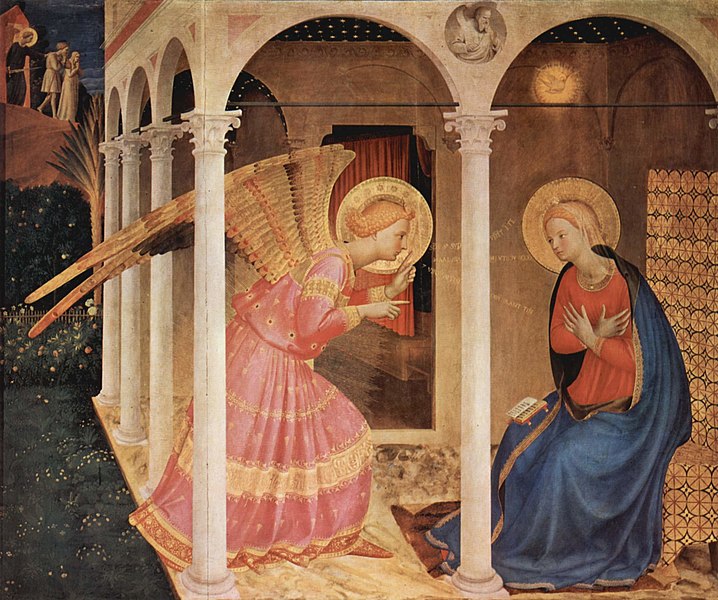All AP Art History Resources
Example Questions
Example Question #1 : Renaissance To Contemporary 2 D Art
Each of these paintings portray a story from __________.
the Old Testament of the Bible
Roman history
the New Testament of the Bible
Greek mythology
the New Testament of the Bible
These two images each portray an important story from the Gospels in the New Testament, the four books that tell the life of Jesus Christ. The image on the left is of the Annunciation, the announcement an angel made to the Virgin Mary telling her that she was pregnant with the Christ child. It was painted in 1433 by Fra Angelico. The image on the right is of the risen Jesus encountering his disciples in Emmaus, painted by Caravaggio in 1606.
Figure 3: The Annunciation (Cortona) by Fra Angelico (1433)
Figure 4: Supper at Emmaus (Milan) by Caravaggio (1606)
Example Question #2 : Renaissance To Contemporary 2 D Art
Images like the painting shown in Figure 3 were particularly important for Christians who were __________.
illiterate
heretics
educated
clergy
illiterate
Most people in Medieval Europe could not read or write, but the Catholic church had a vested interest in helping all of its members to become familiar with and understand the stories of the Bible. A painting like the one presented here by Fra Angelico not only shows the Angel Gabriel telling the Virgin Mary of her status as the mother of the Christ child, but gives a larger symbolic structure to the event.
Figure 3: The Annunciation (Cortona) by Fra Angelico (1433)
Figure 4: Supper at Emmaus (Milan) by Caravaggio (1606)
Example Question #3 : Renaissance To Contemporary 2 D Art

Figure 1

Figure 2
The man in red in the lower image is most likely __________.
Saint Luke
Saint Matthew
Saint John
Saint Mark
Saint Luke
In the Christian tradition, particularly in Medieval Christianity, the inventor of Christian icons and the first person to paint any images of Christ was the Evangelist Saint Luke. In his 1440 painting, "Saint Luke Drawing the Virgin, the early Netherlandish painter Rogier van der Weyden includes someone painting the Madonna and Child with a book open at his feet. Both of these clues indicate that the figure is Saint Luke.
Example Question #4 : Renaissance To Contemporary 2 D Art

Figure 1

Figure 2
Figure 1 is remarkable for its inclusion of __________.
a convex mirror
an animal
the artist's patron
a woman as well as a man
a convex mirror
In the very back of the painting, the "Arnolfini Portrait" by Jan van Eyck, is a convex mirror that is positioned directly between the two main figures. This mirror reflects the back of the couple, and the entire room. The use of such a device was peculiar for medieval art, but presaged some of the new approaches that would be taken during the Italian Renaissance.
Example Question #5 : Renaissance To Contemporary 2 D Art

Figure 1

Figure 2
The garden in the background of Figure 2 represents __________.
temptation
earthly pleasures
innocence
the natural world
innocence
As an image of Christian devotion, Rogier van der Weyden's "Saint Luke Drawing the Virgin" is laced with important symbolism, including the small garden seen through the window in the painting's background. For Christians, any garden is a reference to the Garden of Eden, the earthly paradise where Adam and Eve were innocent before disobeying God. This notion of innocence is also reflected in the fact that this is a portrait of the Virgin Mary, who was believed to have never sinned.
Example Question #1 : Fourteenth Through Sixteenth Century 2 D Art

Figure 1

Figure 2
Figure 1 features the dog as a possible symbol of __________.
the domestic life ahead of the couple
the failure of the marriage
humanity's animal nature
the beastly nature of marriage
the domestic life ahead of the couple
Many wealthy women in the middle ages and early modern era kept lap dogs as pets, which were seen as symbols of their motherly caring before they were married. Jan van Eyck places the dog in the middle of his Arnolfini Portrait, making it already a member of this new family.
Example Question #1 : Fourteenth Through Sixteenth Century 2 D Art


Both of these images were painted in _________.
France
Holland
Italy
Spain
Italy
Each of these images, Leonardo da Vinci's 1489 "Lady with an Ermine" and Sandro Botticelli's 1486 "The Birth of Venus", are classic examples of Italian Renaissance paintings. Da Vinci painted in Milan, under the patronage of the Sforza family, the longtime Dukes of Milan. Botticelli had the Medici family as patrons in the city-state of Florence.
Example Question #8 : Renaissance To Contemporary 2 D Art

The painting depicts a scene from ___________.
Greek mythology
the New Testament
Roman history
the Old Testament
Greek mythology
Botticelli's "The Birth of Venus" portrays a story from Greek mythology. This is common in Italian Renaissance art.
Example Question #9 : Renaissance To Contemporary 2 D Art

In the painting, the animal represents _____________.
purity
sensuality
disgrace
intellectualism
purity
The animal is an ermine (which is a type of weasel). In Leonardo da Vinci's time, the ermine was commonly used throughout Europe as a symbol for purity.
If you don't remember something like this on test day, you can still make an educated guess. For example, you might not remember anything about ermines, but perhaps you remember that white doves are often used in art to symbolize purity. That would lead you to the correct answer.
At the very least, you can probably eliminate the answers "disgrace" and "sensuality" just from looking at the painting. Eliminating two of the four answer choices doubles your chances of guessing correctly.
Example Question #10 : Renaissance To Contemporary 2 D Art

The painting demonstrates _____________, which was introduced during the Renaissance.
the inclusion of animals
the capturing of movement
the creation of female portraits
the use of jewelry
the capturing of movement
While da Vinci's "Lady with an Ermine" is an excellent portrait in its own right, the truly revolutionary aspect of the work is the small sense of motion in the painting. Da Vinci's subject is turning ever so slightly and is captured in a small amount of tension. The ability to capture movement was something introduced during the Renaissance.
Certified Tutor
Certified Tutor
All AP Art History Resources






